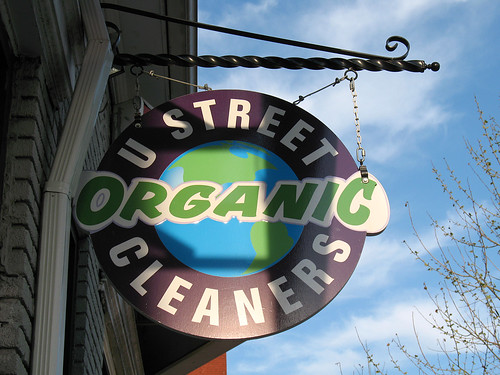
‘U Street Organic Cleaners’
courtesy of ‘Mr. T in DC’
All I wanted was a soft, fluffy bath rug that would keep my shower-fresh tootsies off the cold tile and that wasn’t made in a way that beat up the planet. It seemed a simple enough request.
And so when on my trip to the store I found one with a sign saying “biodegradeable / environmentally friendly,” I snapped it up. True, it had no plastic backing, so it would biodegrade. But it was made of non-organic cotton (each year, 25% of the world’s pesticides go to grow cotton) and viscose, which I hadn’t heard of and hoped was some new environmental fiber. It isn’t; Wikipedia, which I’m using as a source here, says viscose is rayon and its manufacture causes so much pollution they’re closing its factories. So this wasn’t an environmentally friendly choice after all.
Sigh. What’s a greenie to do?
Even when you have the best intentions, it’s often difficult to know what to buy that’s truly eco-friendly. Luckily for us, three fine ladies gave a talk on this topic last Wednesday, at a meeting of the DC EcoWomen’s Green Economy Eco-mmunity. What are their pearls of wisdom?
Lynn Anne Miller, founder of 4GreenPs; Bernie Prince, co-director of FRESHFARM Markets; and Emily Wurth, Water Campaign Manager for Food and Water Watch gave these tips.
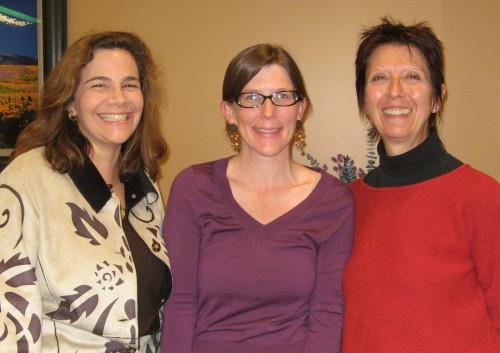
Buying-Green Gurus: Lynn Miller, Emily Wurth and Bernie Prince
Buy local, and eat with the seasons. Once you eat a fresh local peach, you’ll never go back to out-of-season peaches again, said Wurth; the taste of local food is phenomenal.
“Eating with the seasons is the best way to go; you’re eating with the bounty, which means better prices,” said Miller. And local food lasts longer, adding to the savings. In the health and eco-friendly arenas, it likely is grown with fewer chemicals. Plus, “by going direct to the farmer, you’re going directly to the people who grew it and are paying a fair price” for food, said Wurth.
Ask a lot of questions. Even at the farmers market, ask about the food. How were the lambs treated? Where did the berries come from? Did the farmer grow them herself? Check out the oysters or crabs at the farmers market, and “you can talk to the waterman who caught them,” said Prince. “Ultimately, it’s best to buy directly from the person who produced the food,” said Wurth.
Not getting the answers you need at the grocery store? Look it up on the Web, said Wurth. A good company will spell out where its products came from. The GoodGuide mobile will send this info direct to your phone. “With your iPhone, everything is possible now,” she quipped.
At a restaurant, ask where the food comes from, or ask to see a list of purveyors. Feel weird about that? It’s a fair question — you’re buying the item, said the panelists.
Read labels. Products we use every day like deodorant, mouthwash and soaps commonly contain chemicals that can harm our watersheds, the earth and our bodies, said Miller.
There is no standard for organic personal care products, she said, and even some that have organic ingredients may still contain chemicals. So find out what’s in that sweet-smelling lotion before you plunk down your money for it. “You always have to read labels,” said Miller. The word “natural” can be meaningless. Or it can simply mean the company felt it couldn’t afford USDA organic certification, said Miller.
Reading the ingredients will help you to know. Look for products without artificial colorings and preservatives. My personal rule of thumb is that if I can’t pronounce or don’t know what certain ingredients on the list are, then I know to question the product. The Cosmetic Safety Database gives safety scores on many cosmetics so you can look up your own deodorant or shampoo. Eco-labels can help you evaluate many different kinds of products, from food to wood to cleaners.
You also can find natural products like the soap scented from distilled lavender that’s sold at the White House farmers market, said Prince.
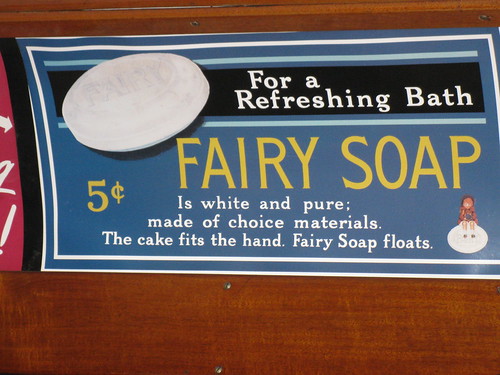
‘Fairy Soap’
courtesy of ‘Stevie Rocco’
Learn what “organic” and other names mean. USDA certified organic is the best, because it’s certified, said Wurth. The USDA inspects farms, and “organic” carries more accountability than other certifications, she said. Certified organic means no genetically modified organisms, irradiation, pesticides, synthetic fertilizers or sewage sludge are used in the food, and that the animals are raised without growth hormones or antibiotics. For example, soy sounds healthy, but “soy can be one of the most highly genetically modified crops out there,” said Miller. “So you want to look for food that’s organic.”
Another label to look for is Certified Humane, said Wurth. Other designations include Cage-free, Fresh, Natural and so on, though many are limited in what they actually guarantee. You can find guides at Decoding Food Labels. Also check out the Dirty Dozen and Clean 15 to find out which foods are best bought organic and which normally retain the fewest pesticides.
Fish from the U.S. is generally best; the country of origin must be labeled if fish is fresh, but not if it’s processed, said Wurth.
While these certifications are a good start, they are not a guarantee. Certified organic does not mean that the food is raised on a small, local or family farm or that animals were treated humanely. There are organic feedlots, said Wurth, where animals spend their lives packed together, and Prince added that “cage-free” could mean the chickens were kept in a small pen. “If most people knew how the meat was raised, they wouldn’t be buying it,” Prince said.
How do you get around that? Figure out which qualities are most important to you personally — the environment, animal rights, etc. And ask questions.
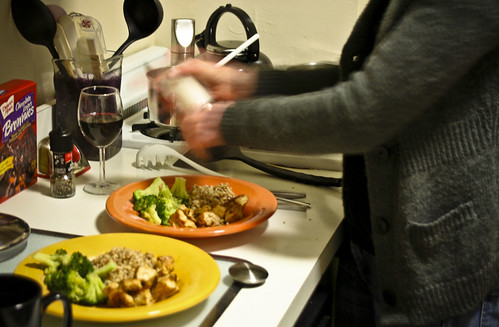
‘Day 14: Rachel Cooking’
courtesy of ‘InspirationDC’
Make it yourself. “One thing the green movement has lost is that it really all is about simplicity,” said Miller. For example, with cooking, “you can have fun and invite friends over,” said Miller. Go to LocalHarvest.org to find a farmers market near you or a Community Supported Agriculture (CSA) group that delivers fresh produce to you each week and learn how to cook local foods. Since joining a CSA, “I can’t imagine the season passing without these vegetables,” said Wurth.
You can even save money that way. Take bread, for instance. “For $1 a loaf, you can make at home something that would cost $4.50 in DC,” said Miller. Visit TheSmartMama.com for recipes for eco-friendly home cleaning products, “potions for making Castile soap and things like that,” she added.
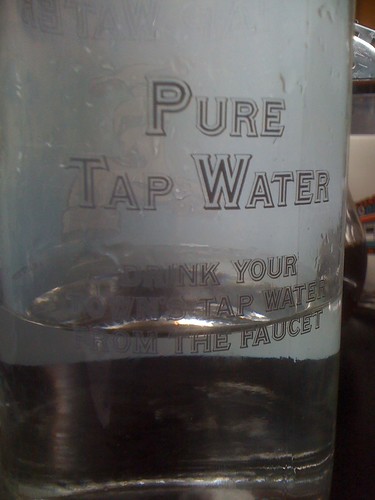
‘Tap Water’
courtesy of ‘Dan4th’
Steer clear of bottled water. We already have a water distribution system, said Wurth, and making one liter of bottled water uses 2,000 times more energy than drawing the same amount from the tap.
“My pitch on bottled water: There’s a lot of marketing on that product,” said Wurth. She mentioned as one example the brand Pure Life, which apparently contains bottled community water and shows happy families in its ads.
If the green message isn’t enough to put a red light on bottled water, there’s also safety to consider, and a database that lets you look up your favorite brand and see if it’s been tested.
The results just might make you green.
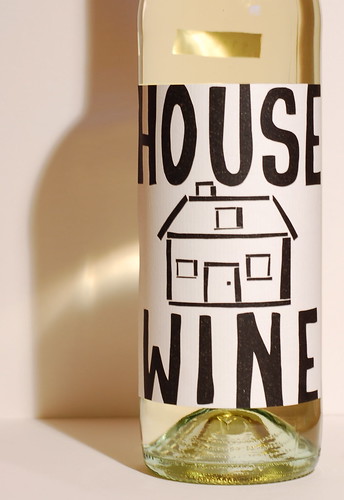
The problem with citing safety as an issue regarding bottled water is that tap water has been adulterated by governments over the decades in the name of ‘health and safety’, and there are so many occasions when the government agencies’ own departments tell people NOT to drink tap water because of infections and scares. I am probably unusual in being someone who has never bought a bottle of water, simply on grounds of the absurdity of paying good money for something that I already pay for through taxes, but the issue of public water supply is much more complicated than people sometimes think, and choice is vital. Another interesting fact is that, sadly, campaigns against bottled water among the young lead to a rise in them buying carbonated drinks or ‘flavoured waters’ (groan) because, of course, they are marketed as somehow ‘green’.
Damian, thank you for sharing your thoughts on this. I hear your point that if tap water is bad there should be an alternative, but bottled water often is tap water. And it’s not necessarily safe, either. Here’s a piece that outlines some of the issues: http://www.foodandwaterwatch.org/water/bottled/bottled-water-illusions-of-purity It goes back to the “ask questions” part – online databases and calling around are good ways to find out where water, tap or bottled, comes from and if it’s been tested.
As for carbonated drinks, hooray, there’s a solution for reducing those bottles, too – home soda makers like this: http://www.sodaclub.com. There’s a big box by my door that just arrived with one, fresh from the Green Festival, so I’m curious to see how it does!
Donna, what a great and thorough article. I, too, attended the meeting. You did an excellent job capturing what each woman addressed. I think the bottom line, as you clearly stated, is stay awake, read labels, ask questions and do your best.
My top take away from the meeting: farmers do deserve a living wage and in exchange for quality food, I can support them. I’m contacting CSA’s in my area to see if I can connect with one for the winter crops.